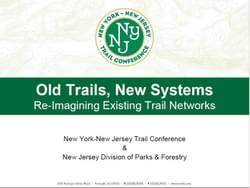




Are you ready to view old trail networks with fresh eyes?
by Peter Dolan, New Jersey Program Coordinator, New York - New Jersey Trail Conference, Joshua Osowski, Regional Park Superintendent

| Many trail networks grow organically over the years – linear trails sprout connectors, spurs snake toward vistas, “social trails” are marked, and new trails are added to provide loop options. With enough time, even trail systems that are fastidiously maintained on the ground can look confusing on a map. When people are getting lost and trails aren’t meeting hiker needs, what can you do? This presentation uses examples of real-world trail networks that were re-imagined with simple re-blazing and strategic use of new connectors to provide radically improved user experiences. Undertaking such projects requires the involvement of land managers, nonprofit partners, volunteers, and the input of emergency first responders… but when a tangled mess of trails evolves into an elegant system of stacked loops, the result is worth it. After walking through the projects described in this presentation, the audience will be ready to view old trail networks with fresh eyes. Learning Objectives:
|
posted Apr 17, 2024
This report summarizes guidance and best practices to create safer bicycle facilities and connect them into networks that allow more people to safely bike to more places within and throughout communities.
Setting Speed Limits for Health and Safety
posted Apr 17, 2024
This mini-report on setting speed limits shows the current framework for speed limit policies through a review of state laws that set speed limits.
posted Nov 14, 2023
These case studies reveal a number of lessons learned that will be valuable in future winter travel management planning efforts.
TRAILS SAFE PASSING PLAN: STOP, SPEAK, and STAND BACK
posted Feb 14, 2023
Horses are prey animals and naturally can be afraid of unfamiliar people and objects. Horses have natural "flight“ survival instincts and prefer to move their feet towards an exit route. Therefore, people with horses should pass at a walk while other trail users remain STOPPED until passed.
645 views • posted 06/05/2019